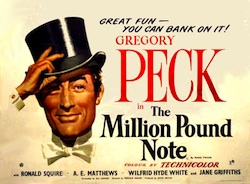Ronald Neame directed this British comedy, starring American Gregory Peck, and Brit thesps Ronald Squire, Wilfrid Hyde-White and Jane Griffiths.
Grade: B-
| The Million Pound Note | |
|---|---|

British theatrical poster
|
|
Based on the 1893 Mark Twain short story, “The Million Pound Bank Note,” it’s considered to be a precursor to Eddie Murphy’s 1983 comedy, Trading Places.
In 1903, American seaman Henry Adams (Peck), stranded penniless in Britain, gets caught up in unusual wager between two wealthy eccentric brothers, Oliver and Roderick Montpelier. They persuade the Bank of England to issue a one million pound banknote, which they present to Adams in an envelope.
Oliver asserts that the mere existence of the note will enable its possessor to obtain whatever he needs, while Roderick insists that it would have to be spent in order to be of any use.
Adams, shocked of discovering the note’s worth, tries to return it to the brothers, but is told that they have left. He then finds a letter explaining the wager and promising him a job if he can avoid spending the note.
At first, everything goes according to Oliver’s plan. Mistaken for eccentric millionaire, Adams gets food, clothes, and hotel suite just by showing his note.
After the story of the note becomes public, Adams is welcomed into exclusive social circles, meeting the American ambassador and English aristocracy. He becomes friendly with Portia Lansdowne, the niece of the Duchess of Cromarty.
Meanwhile, fellow American Lloyd Hastings asks him to back a business venture, claiming that his mere association will raise the money needed to develop his gold mine by selling shares.
The Duke of Frognal, evicted from the suite Adams now occupies, hides the note as a joke, and Adams inability to produce the note causes panic amongst the shareholders and his creditors.
All is straightened out in the end, when Adams is able to return the note to the Montpelier brothers.
It was shot at Pinewood Studios and on location around London. The film’s sets were designed by the art directors John Box and Jack Maxsted.
It was released by Rank’s General Film Distributors, while the American release was handled by United Artists under the title Man with a Million.
Director Ronald Neame and producer John Bryan had just enjoyed big success for Rank with The Card, a comedy based on a novel. They decided to film Mark Twain’s short story and hired Jill Craigie to adapt it to the screen; the story had previously been done on British TV in 1950.
As Rank Organization wanted a star to play the lead role, Neame and Bryan approached Gregory Peck, who was then in France, dating Veronique, the woman he would marry. Peck wanted to stay in Europe, liked the screenplay and agreed to make the film. Peck agreed to make another film in England for Rank, The Purple Plain, as well as a film in Germany, Night People.
Neame wished Dinah Sheridan to play the female lead but she had retired, and so Jane Griffiths was cast.
The majority of shoot took place in Pinewood Studios, with sets designed by John Box and Jack Maxsted; other locations included the Belgrave Square.
Given royal premiere in Auckland New Zealand, attended by the Queen and the Duke of Ediburgh, the film was very popular in Australia.
The film failed, earning rentals of only $1.1 million in America, which critic Pauline Kael attributed to the fact that Americans assumed from the author’s name that the film (set in Mark Twain’s period) was a dull classic.”
Other critics claimed that Peck, a solid if uniquely American actor, was miscast in a role that should have been played by a comedian like Alec Guinness.
Cast
Gregory Peck as Henry Adams
Ronald Squire as Oliver Montpelier
Wilfrid Hyde-White as Roderick Montpelier
Jane Griffiths as Portia Lansdowne
Joyce Grenfell as Duchess of Cromarty
A. E. Matthews as Duke of Frognal
Maurice Denham as Mr. Reid
Reginald Beckwith as Rock
Brian Oulton as Lloyd
John Slater as Parsons
Wilbur Evans as American ambassador
Hartley Power as Hastings
George Devine as restaurant proprietor
Bryan Forbes as Todd
Hugh Griffith as Potter
Credits:
Directed by Ronald Neame
Screenplay by Jill Craigie, based on “The Million Pound Bank Note” by Mark Twain
Produced by John Bryan, Earl St. John, Ronald Neame
Cinematography Geoffrey Unsworth
Edited by Clive Donner
Music by William Alwyn
Production: Group Film Productions
Distributed by General Film Distributors
Release date: January 7, 1954
Running time: 90 minutes
Box office $1.1 million (rentals, US)










